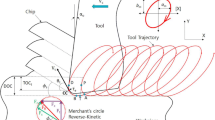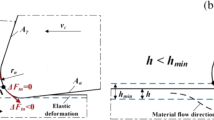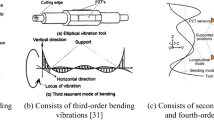Abstract
This paper presents some results achieved in the ultra-precision manufacturing, microelectronics engineering, as well as bioengineering applications of vibration-assisted swing cutting (VASC) technology, and describes the resolved and unresolved challenges presented by VASC manufacturing. In particular, it outlines the residual-height between adjacent trajectories in EVC process technology cannot be eliminated, which has the effect of alleviating this problem. Based on matrix-based compliance modeling, the stroke of the PZTs and the allowable stress of the material on the work-space were analyzed. Theoretical modeling was validated by finite element analysis (FEA). The results showed that the max-stroke of the PZTs and the Von Mises stress could reach up to 16.67 μm and 196.6 MPa in the theoretical, respectively. The max-stroke of the PZTs and the Von Mises stress could reach up to 19.50 μm and 158.9 MPa in the finite element analysis, respectively. Cutting experiment was carried out on the basis of VASC design and modeling, which further verified the large work-space and the VASC technology can suppress residual-height between adjacent trajectories effectively. Thus, the superior performances and easily achievable high surface machining accuracy well facilitate practical applications of the VASC system in micro-/nano machining.






Similar content being viewed by others
References
Ahn JH, Lim HS, Son SM (1999) Improvement of micro-machining accuracy by 2-dimensional vibration cutting. Proc ASPE 20:150–153
Bo W, Zhenyu Z, Keke C, Junfeng C, Andreas R, Jinhong Y et al (2018) New deformation-induced nanostructure in silicon. Nano Lett 18:4611
Bruzzone AAG, Costa HL, Lonardo PM, Lucca DA (2008) Advances in engineered surfaces for functional performance. CIRP Ann Manuf Tech 57(2):750–769
Fan QW, Wang P, Zhang HQ, Gao XJ (2010) Analysis of running mechanism of crossover operators in genetic algorithm. J Beijing Univ Technol 36(10):1328–1336
Huang H, Li B, Deng Z, Hu Y (2012) A 6-DOF adaptive parallel manipulator with large tilting capacity. Robot Comput Integr Manuf 28(2):275–283
Junfeng H, Xingxing Z, Shuai Y, Yifei L (2018) Design of a new type of large working space and decoupled micro-operation platform. Mech Des 35(09):79–85 (in chinese)
Kind H, Bonard JM, Emmenegger C, Nilsson LO, Hernadi K, Maillardschaller E et al (1999) Patterned films of nanotubes using microcontact printing of catalysts. Adv Mater 11(15):1285–1289
Kolar JW, Round SD (2006) Analytical calculation of the RMS current stress on the DC-link capacitor of voltage-PWM converter systems. IEE Proc IET Electr Power Appl 153(4):535
Lin J, Zhao D, Lu M, Yi A (2018) Modeling and analysis of a novel decoupled vibration-assisted swing cutting system for micro/nano-machining surface. IEEE Access 6:70388–70396
Lu M, Hao W, Liang G, Lin J, Yan G, Chen B et al (2018a) Modeling and analysis of surface topography of Ti6Al4V alloy machining by elliptical vibration cutting. Int J Adv Manuf Technol 98(9–12):2759–2768
Lu M, Zhao D, Lin J, Zhou X, Zhou J, Chen B et al (2018b) Design and analysis of a novel piezoelectrically actuated vibration assisted rotation cutting system. Smart Mater Struct 27(9):095020
Neinhuis C, Barthlott W (1997) Characterization and distribution of water-repellent, self-cleaning plant surfaces. Ann Bot 79(6):677
Riedl A, Daniel R, Stefenelli M, SchBerl T, Kolednik O, Mitterer C et al (2012) A novel approach for determining fracture toughness of hard coatings on the micrometer scale. Scr Mater 67(7–8):708–711
Song G, Zhao J, Zhou X, Abreu-Garcia JAD (2005) Tracking control of a piezoceramic actuator with hysteresis compensation using inverse Preisach model. IEEE ASME Trans Mechatron 10(2):198–209
Suzuki H, Moriwaki T, Okino T, Ando Y (2006) Development of ultrasonic vibration assisted polishing machine for micro aspheric die and mold. CIRP Ann Manuf Technol 55(1):385–388
Xiao S, Li Y (2013) Development of a large working range flexure-based 3-DOF micro-parallel manipulator driven by electromagnetic actuators. In: 2013 IEEE international conference on robotics and automation, pp 4506–4511
Yan J, Zhang Z, Kuriyagawa T (2010) Tool wear control in diamond turning of high-strength mold materials by means of tool swinging. CIRP Ann Manuf Technol 59(1):109–112
Zhang Z, Huo F, Zhang X, Guo D (2012a) Fabrication and size prediction of crystalline nanoparticles of silicon induced by nanogrinding with ultrafine diamond grits. Scr Mater 67(7–8):657–660
Zhang Z, Song Y, Huo F, Guo D (2012b) Nanoscale material removal mechanism of soft-brittle HgCdTe single crystals under nanogrinding by ultrafine diamond grits. Tribol Lett 46(1):95–100
Zhang ZY, Huo YX, Guo DM (2013) A model for nanogrinding based on direct evidence of ground chips of silicon wafers. Sci China Technol Sci 56(9):2099–2108
Zhang SJ, To S, Zhang GQ, Zhu ZW (2015a) A review of machine-tool vibration and its influence upon surface generation in ultra-precision machining. Int J Mach Tools Manuf 91:34–42
Zhang Z, Bo W, Kang R, Bi Z, Guo D (2015b) Changes in surface layer of silicon wafers from diamond scratching. CIRP Ann Manuf Technol 64(1):349–352
Zhang Z, Huang S, Wang S, Wang B, Bai Q, Zhang B, Guo D (2017) A novel approach of high-performance grinding using developed diamond wheels. Int J Adv Manuf Technol 91(9–12):3315–3326
Zhu ZW, Zhou XQ, Wang RQ, Liu Q (2015) A simple compliance modeling method for flexure hinges. Sci China Technol Sci 58(1):56–63
Acknowledgements
This research was financially supported by the Ministry of Science and Technology State Key Support Program (2016YFE0105100), MicroNano and Ultra-Precision Key Laboratory of Jilin Province (20140622008JC) and Science and Technology Development Projects of Jilin Province (20180101034JC, 20180201052GX, 20190201303JC), Education Department Scientific Research Planning Project of Jilin Provincial (JJKH20181038KJ).
Author information
Authors and Affiliations
Corresponding author
Additional information
Publisher's Note
Springer Nature remains neutral with regard to jurisdictional claims in published maps and institutional affiliations.
Rights and permissions
About this article
Cite this article
Lu, M., Chen, J., Zhao, D. et al. Modeling and realization of work-space analysis of a piezoelectric actuator 2-DOF vibration-assisted swing cutting system. Appl Nanosci 11, 777–785 (2021). https://doi.org/10.1007/s13204-019-01079-1
Received:
Accepted:
Published:
Issue Date:
DOI: https://doi.org/10.1007/s13204-019-01079-1




